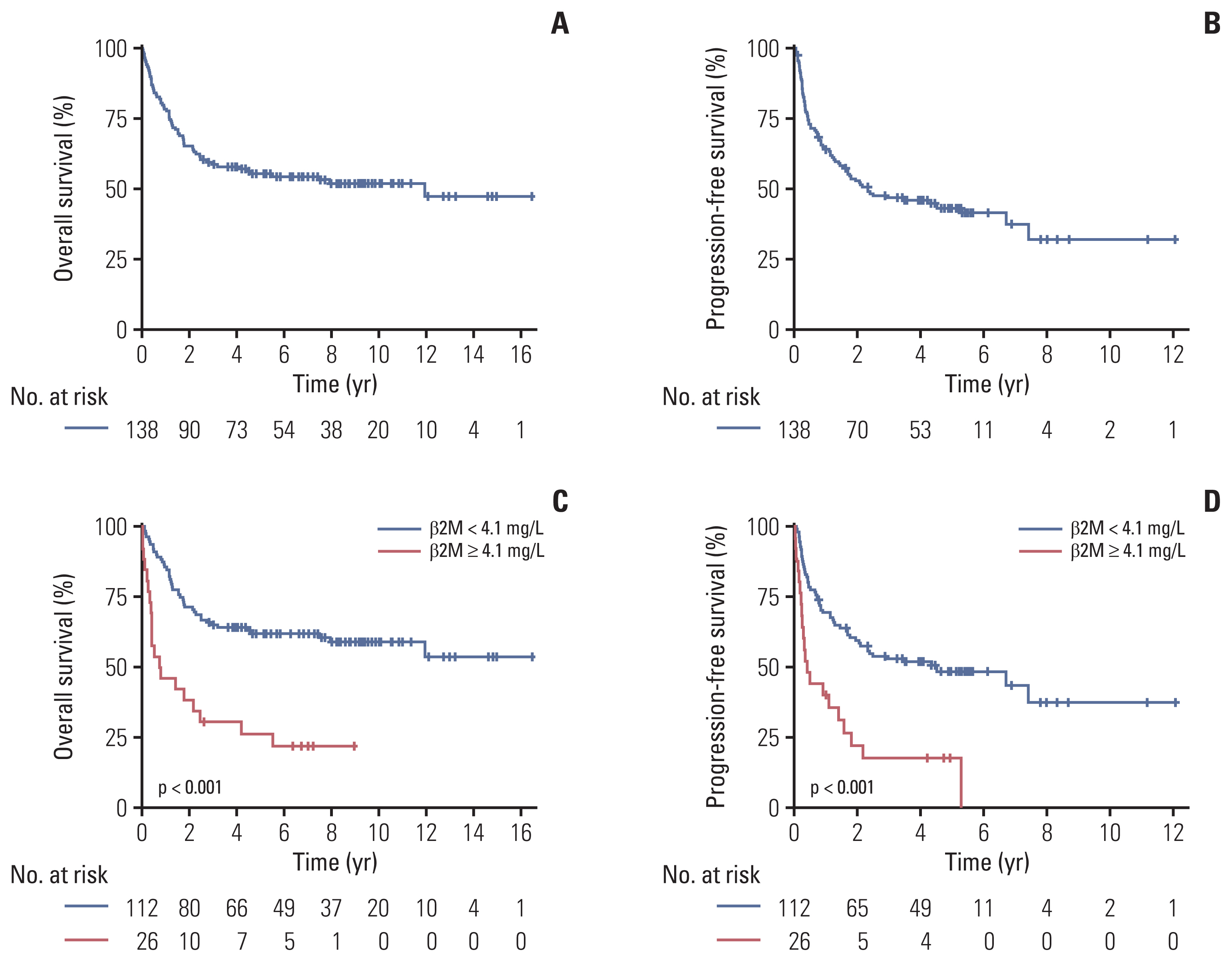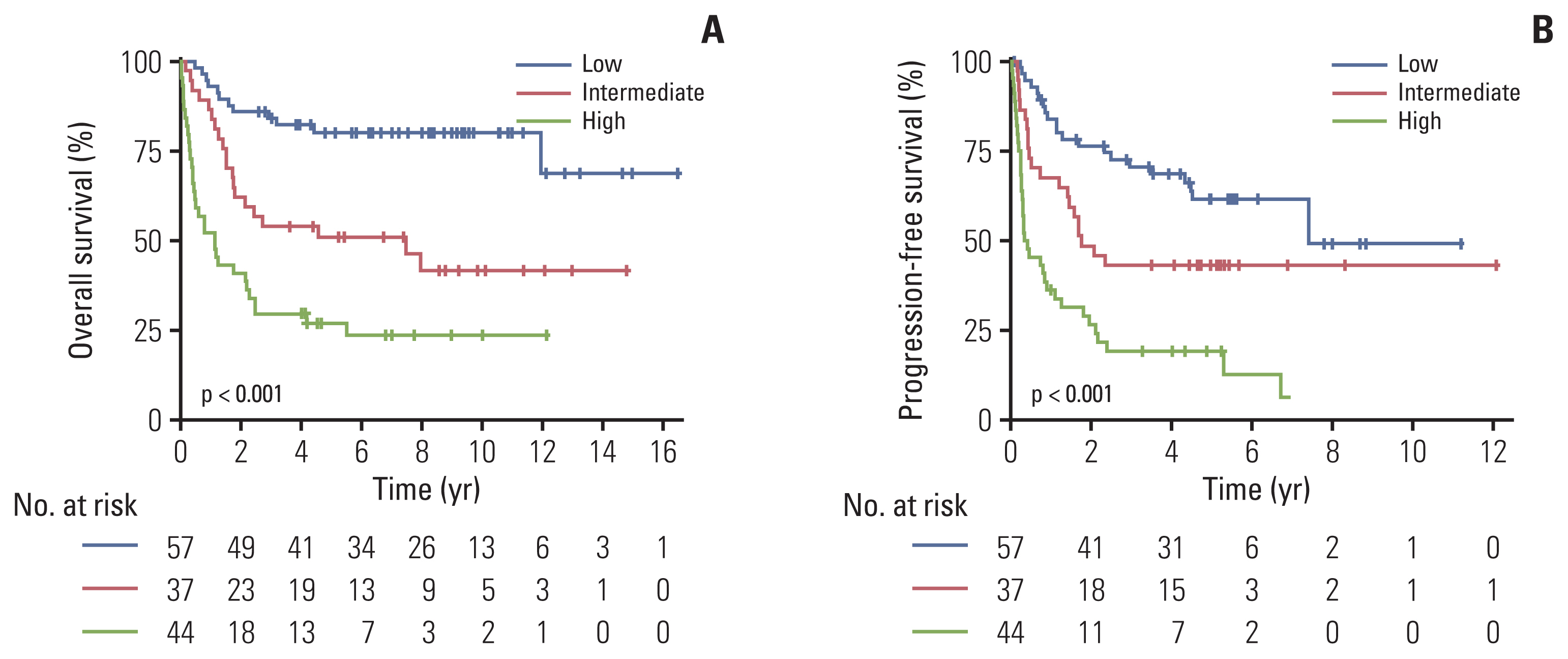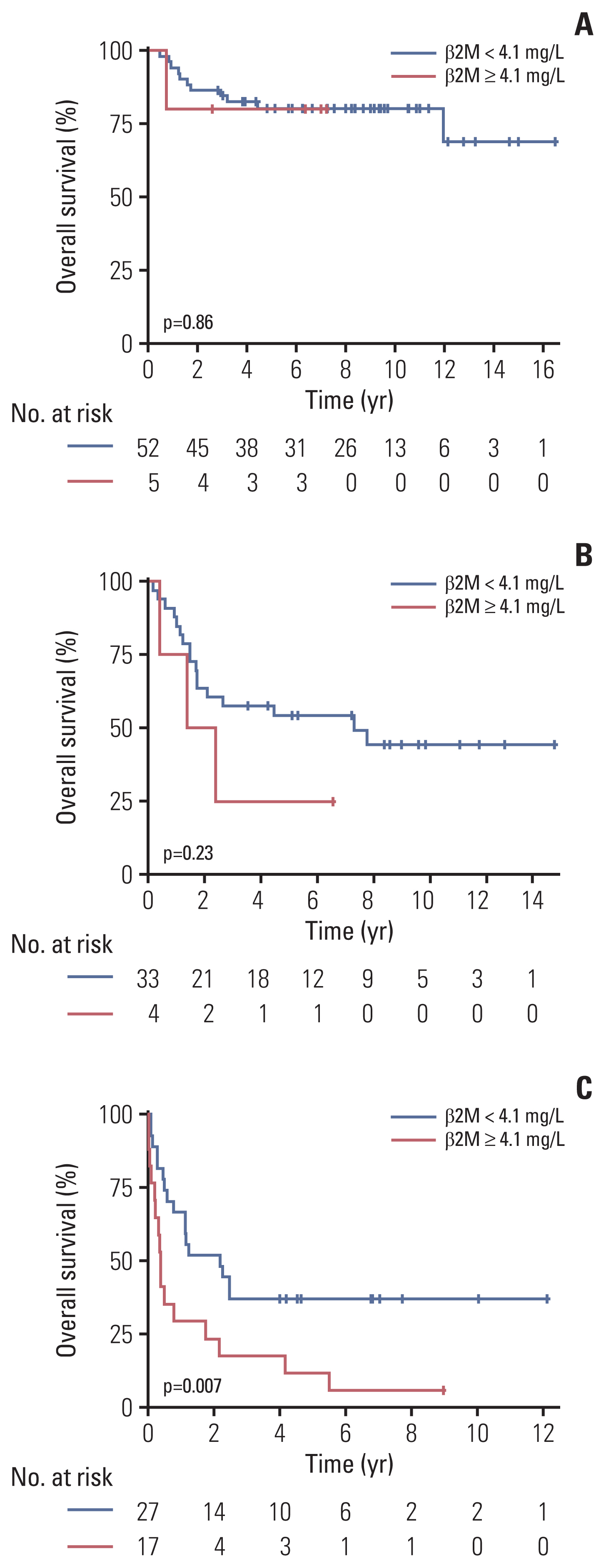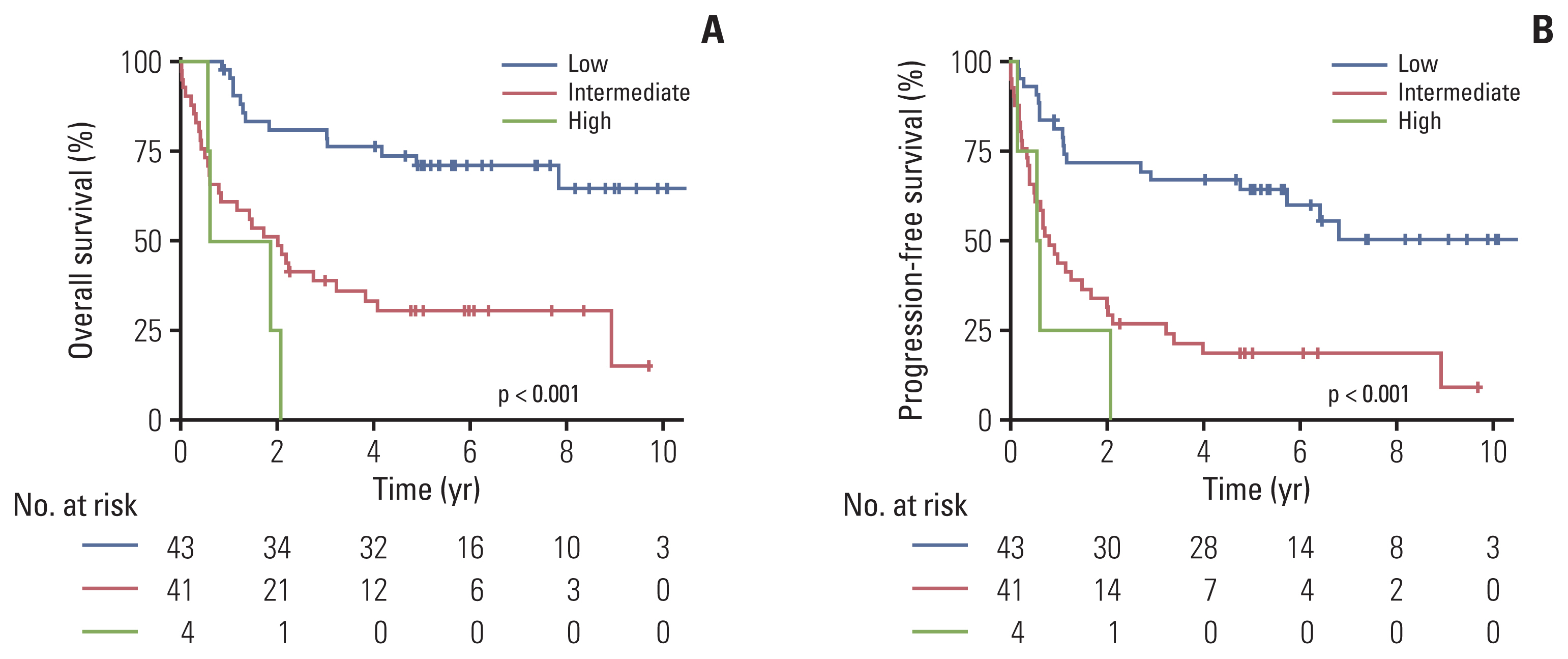Cancer Res Treat.
2023 Jan;55(1):314-324. 10.4143/crt.2022.015.
A New Prognostic Index for Extranodal Natural Killer/T-Cell Lymphoma:Incorporation of Serum β-2 Microglobulin to PINK
- Affiliations
-
- 1Department of Oncology, Asan Medical Center, University of Ulsan College of Medicine, Seoul, Korea
- 2Department of Otolaryngology, Asan Medical Center, University of Ulsan College of Medicine, Seoul, Korea
- 3Department of Pathology, Asan Medical Center, University of Ulsan College of Medicine, Seoul, Korea
- 4Department of Nuclear Medicine, Asan Medical Center, University of Ulsan College of Medicine, Seoul, Korea
- 5Department of Radiation Oncology, Asan Medical Center, University of Ulsan College of Medicine, Seoul, Korea
- 6Division of Hematology and Oncology, Department of Internal Medicine, Samsung Medical Center, Sungkyunkwan University School of Medicine, Seoul, Korea
- 7Department of Pathology, Samsung Medical Center, Sungkyunkwan University School of Medicine, Seoul, Korea
- KMID: 2538014
- DOI: http://doi.org/10.4143/crt.2022.015
Abstract
- Purpose
Prognostic Index for Natural Killer Lymphoma (PINK) is the most widely accepted prognostic model for patients withextranodal natural killer/T-cell lymphoma (ENKTL) treated with non-anthracycline–based therapy. We aimed to evaluate the prognostic implications of serum β-2 microglobulin (β2M) in the context of PINK and proposed a new prognostic model.
Materials and Methods
A total of 138 patients who were newly diagnosed with ENKTL and treated with non-anthracycline-based chemotherapy were identified. The cut-off value of high serum β2M was calculated by maximal-chi square methods (4.1 mg/L). A new prognostic model incorporating serum β2M into PINK was proposed and validated in an independent validation cohort (n=88).
Results
The patients’ median age was 53.5 years (range, 19 to 80 years). Patients with high serum β2M levels had significantly worse overall survival (OS) and progression-free survival (PFS). In multivariate analysis, high serum β2M was an independent adverse prognostic factor for OS. A new PINK-B (Prognostic Index for Natural Killer Lymphoma-serum β-2 microglobulin) model stratifiedpatients into three groups with distinct OS and PFS in the training cohort (3-year OS, 84.1% [95% confidence interval, 75.1 to 94.2], 46.8% [36.1 to 60.8] and 17.6% [6.3 to 49.2] for the low-, intermediate, and high-risk groups, respectively; 3-year PFS, 70.6% [59.4 to 83.8], 35.9% [25.9 to 49.8], and 7.35% [1.1 to 46.7] for the low-, intermediate-, and high-risk groups, respectively). The PINK-B model was further validated in an independent cohort.
Conclusion
Serum β2M is an independent prognostic factor for ENKTL patients. The new serum β2M-based prognostic model may be useful for identifying ultra-high-risk patients, and it can easily be adopted into daily clinical practice.
Keyword
Figure
Reference
-
References
1. Haverkos BM, Pan Z, Gru AA, Freud AG, Rabinovitch R, Xu-Welliver M, et al. Extranodal NK/T cell lymphoma, nasal type (ENKTL-NT): an update on epidemiology, clinical presentation, and natural history in North American and European cases. Curr Hematol Malig Rep. 2016; 11:514–27.2. Wang H, Fu BB, Gale RP, Liang Y. NK-/T-cell lymphomas. Leukemia. 2021; 35:2460–8.3. Yamaguchi M, Suzuki R, Oguchi M. Advances in the treatment of extranodal NK/T-cell lymphoma, nasal type. Blood. 2018; 131:2528–40.4. Tse E, Kwong YL. How I treat NK/T-cell lymphomas. Blood. 2013; 121:4997–5005.5. Lim SH, Hong JY, Lim ST, Hong H, Arnoud J, Zhao W, et al. Beyond first-line non-anthracycline-based chemotherapy for extranodal NK/T-cell lymphoma: clinical outcome and current perspectives on salvage therapy for patients after first relapse and progression of disease. Ann Oncol. 2017; 28:2199–205.6. Kim SJ, Yoon DH, Jaccard A, Chng WJ, Lim ST, Hong H, et al. A prognostic index for natural killer cell lymphoma after non-anthracycline-based treatment: a multicentre, retrospective analysis. Lancet Oncol. 2016; 17:389–400.7. Dasgupta A, Wahed A. Tumor markers. Dasgupta A, Wahed A, editors. Clinical chemistry, immunology and laboratory quality control. San Diego, CA: Elsevier;2014. p. 229–47.8. Yoo C, Yoon DH, Suh C. Serum beta-2 microglobulin in malignant lymphomas: an old but powerful prognostic factor. Blood Res. 2014; 49:148–53.9. Yoo C, Yoon DH, Jo JC, Yoon S, Kim S, Lee BJ, et al. Prognostic impact of beta-2 microglobulin in patients with extranodal natural killer/T cell lymphoma. Ann Hematol. 2014; 93:995–1000.10. Li ZM, Zhu YJ, Sun J, Xia Y, Huang JJ, Zou BY, et al. Serum beta2-microglobin is a predictor of prognosis in patients with upper aerodigestive tract NK/T-cell lymphoma. Ann Hematol. 2012; 91:1265–70.
Article11. Swerdlow SH, Campo E, Pileri SA, Harris NL, Stein H, Siebert R, et al. The 2016 revision of the World Health Organization classification of lymphoid neoplasms. Blood. 2016; 127:2375–90.12. Coulter Beckman. Instruction for beta 2 microglobulin assay [Internet]. Brea, CA: Beckman Coulter;2022. [cited 2022 Feb 21]. Available from: https://www.beckmancoulter.com/download/file/phxPI-IM111302-EN_US/PI-IM111302?type=pdf .13. Miller R, Siegmund D. Maximally selected chi square statistics. Biometrics. 1982; 38:1011–6.
Article14. Greipp PR, San Miguel J, Durie BG, Crowley JJ, Barlogie B, Blade J, et al. International staging system for multiple myeloma. J Clin Oncol. 2005; 23:3412–20.15. International CLL-IPI Working Group. An international prognostic index for patients with chronic lymphocytic leukaemia (CLL-IPI): a meta-analysis of individual patient data. Lancet Oncol. 2016; 17:779–90.16. Federico M, Bellei M, Marcheselli L, Luminari S, Lopez-Guillermo A, Vitolo U, et al. Follicular lymphoma international prognostic index 2: a new prognostic index for follicular lymphoma developed by the international follicular lymphoma prognostic factor project. J Clin Oncol. 2009; 27:4555–62.17. Kim HD, Cho H, Jeong H, Bang K, Kim S, Lee K, et al. A prognostic index for extranodal marginal-zone lymphoma based on the mucosa-associated lymphoid tissue International Prognostic Index and serum beta2-microglobulin levels. Br J Haematol. 2021; 193:307–15.18. Shang Y, Fu X, Chang Y, Li Y, Zhang M. B2 microglobulin is a novel prognostic marker of Angioimmunoblastic T-cell lymphoma. Sci Rep. 2018; 8:12907.19. Yamaguchi M, Suzuki R, Oguchi M, Asano N, Amaki J, Akiba T, et al. Treatments and outcomes of patients with extranodal natural killer/T-cell lymphoma diagnosed between 2000 and 2013: a cooperative study in Japan. J Clin Oncol. 2017; 35:32–9.20. Kim SJ, Yoon SE, Kim WS. Treatment of localized extranodal NK/T cell lymphoma, nasal type: a systematic review. J Hematol Oncol. 2018; 11:140.21. Ha JY, Cho H, Sung H, Jung AR, Lee YS, Lee SW, et al. Superiority of Epstein-Barr virus DNA in the plasma over whole blood for prognostication of extranodal NK/T cell lymphoma. Front Oncol. 2020; 10:594692.22. Chen R, Wang C, Zhou Y, Wen B. Prognostic implications of circulating Epstein-Barr virus DNA for extranodal natural killer/T-cell lymphoma, nasal type: a meta-analysis. Cancer Manag Res. 2018; 10:2183–92.23. Tan KM, Chia B, Lim JQ, Khoo LP, Cheng CL, Tan L, et al. A clinicohaematological prognostic model for nasal-type natural killer/T-cell lymphoma: a multicenter study. Sci Rep. 2019; 9:14961.24. Lee J, Suh C, Park YH, Ko YH, Bang SM, Lee JH, et al. Extranodal natural killer T-cell lymphoma, nasal-type: a prognostic model from a retrospective multicenter study. J Clin Oncol. 2006; 24:612–8.
- Full Text Links
- Actions
-
Cited
- CITED
-
- Close
- Share
- Similar articles
-
- Serum beta-2 microglobulin in malignant lymphomas: an old but powerful prognostic factor
- Extranodal NK/T cell lymphoma
- A Case of Natural Killer T-cell Lymphoma of the Tongue
- Clinical Impact of Microbiome Characteristics in Treatment-Naïve Extranodal NK/T-Cell Lymphoma Patients
- Extranodal NK/T-Cell Lymphoma, Nasal Type, Extranasal and Ulcerative Blister Variant, Case Report






